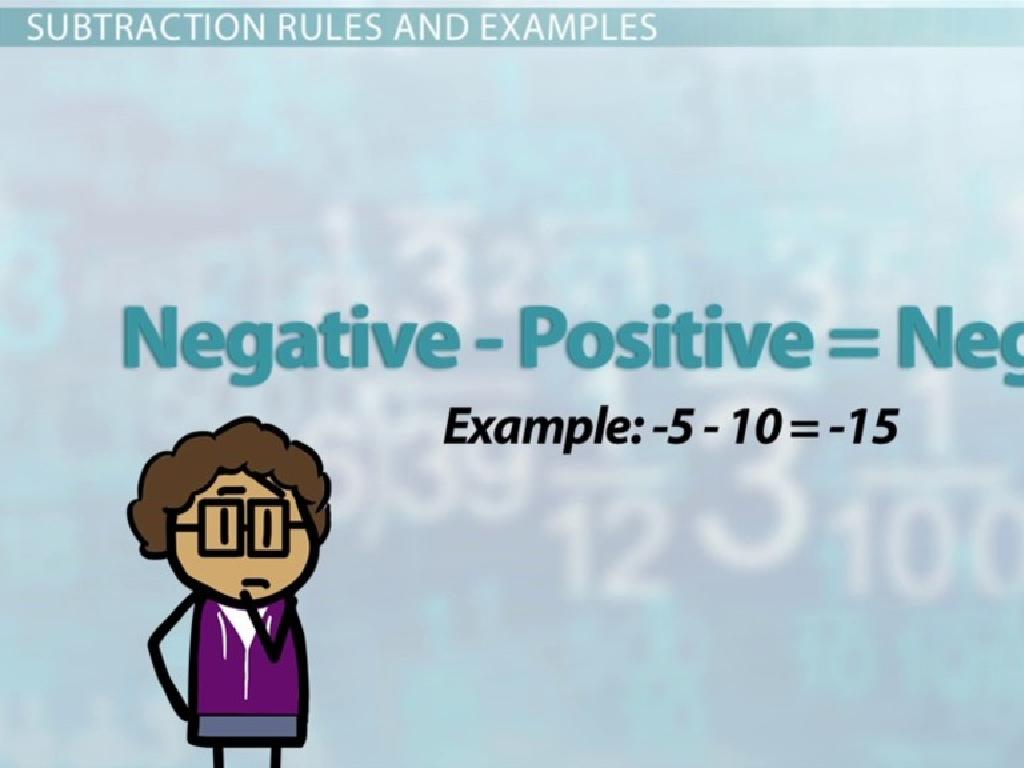Add And Subtract Integers
Subject: Math
Grade: Seventh grade
Topic: Operations With Integers
Please LOG IN to download the presentation. Access is available to registered users only.
View More Content
Adding and Subtracting Integers
– What are integers?
– Integers include positive, negative numbers, and zero.
– Rules for adding integers
– To add, use the same sign if signs match, else find the difference.
– Rules for subtracting integers
– To subtract, add the opposite of the second integer.
– Integer operations in real life
– Examples: temperatures, bank transactions, elevations.
|
Begin the lesson by defining integers and ensuring students understand the concept of positive, negative numbers, and zero. Explain the rules for adding integers, emphasizing the use of the same sign when the signs match and finding the difference when they don’t. For subtraction, teach students to add the opposite of the second integer. Highlight the importance of these operations in real life, such as understanding temperatures below zero, managing bank account deposits and withdrawals, or measuring elevations above and below sea level. Provide practice problems that incorporate real-life scenarios to solidify these concepts.
Understanding Integers
– Define integers
– Integers include whole numbers and their opposites
– Positive vs. negative numbers
– Positive numbers are above zero, negative are below
– Real-life integer examples
– Temperatures, bank balances, and elevations
– Adding and subtracting integers
– Use number lines and rules for combining signs
|
Introduce the concept of integers to the students by defining them as whole numbers including zero, positive numbers, and their opposites, the negative numbers. Illustrate the difference between positive and negative numbers using a number line. Provide relatable examples such as temperatures (above/below freezing), bank balances (deposits/withdrawals), and elevations (above/below sea level). Explain the basic rules for adding and subtracting integers, such as ‘same signs add and keep, different signs subtract’. Use visual aids like number lines to help students understand the process of adding and subtracting integers. Encourage students to think of other real-life scenarios where integers are used and how they are combined.
Adding Integers
– Understand rules for adding
– Same signs add and keep, different signs subtract!
– Use a number line for addition
– Visualize adding positive or negative steps
– Example: 5 + (-3)
– 5 steps forward, 3 steps back results in 2
– Practice with different numbers
|
This slide introduces students to the concept of adding integers. Start by explaining the rules for adding integers: if the signs are the same, add the numbers and keep the sign; if the signs are different, subtract the smaller number from the larger and keep the sign of the larger number. Use a number line to visually demonstrate how to add integers, showing that positive numbers move to the right and negative numbers move to the left. Provide the example 5 + (-3) to illustrate these concepts, where you start at 5 on the number line and move 3 steps back to land on 2. Encourage students to practice with different numbers to solidify their understanding.
Subtracting Integers
– Rules for subtracting integers
– To subtract, change to addition and use the inverse of the second number.
– Subtract by adding the opposite
– Instead of subtracting, add the opposite: (-7) + (-4).
– Example: (-7) – 4
– Calculate: (-7) + (-4) = -11. This shows how subtraction works with negatives.
|
When teaching subtraction of integers, start by explaining the rules: to subtract an integer, add the opposite of the integer you’re subtracting. This turns a subtraction problem into an addition problem, which is often easier to understand and solve. Use the example (-7) – 4 to illustrate this concept. Show that by adding the opposite, the problem becomes (-7) + (-4), which equals -11. This method helps students grasp the concept of subtraction as a form of addition, simplifying the process and reinforcing their understanding of negative numbers. Encourage students to practice with various examples and to check their work by considering the number line.
Adding Integers with Same Signs
– Add numbers with same signs
– When integers have the same sign, combine their absolute values.
– Keep the original sign
– The sum will have the same sign as the integers you’re adding.
– Example: (-2) + (-6)
– Adding two negatives: -2 + -6 equals -8.
|
This slide focuses on the rules for adding integers with the same sign. Emphasize to students that when the signs are the same, they simply need to add the absolute values of the numbers and keep the sign of the integers. Use the example (-2) + (-6) to show that since both numbers are negative, we add 2 and 6 to get 8, and since the original numbers were negative, the answer is -8. Encourage students to practice with additional examples and to remember that this rule applies to both positive and positive or negative and negative integer pairs.
Adding Integers with Different Signs
– Subtract smaller from larger
– When adding -3 and 7, subtract 3 from 7
– Keep the sign of the larger
– The result takes the sign of the larger number, so it’s positive
– Example: (-3) + 7
– The calculation is 7 – 3, which equals +4
|
This slide focuses on the rules for adding integers with different signs. The key takeaway is that when the signs are different, students should subtract the smaller absolute value from the larger absolute value and keep the sign of the larger number. For example, when adding -3 and 7, we subtract 3 from 7 to get 4, and since 7 has a positive sign, the result is +4. It’s crucial to ensure students practice this with various examples to solidify their understanding. Encourage them to think of the numbers as having ‘strength’ and the larger number’s sign wins out.
Subtracting Integers with Same Signs
– Subtract numbers normally
– Just like basic subtraction: 9 – 5
– Retain the original sign
– Since both are positive, the result is positive
– Example: 9 – 5 = 4
– Here, both 9 and 5 are positive, so the answer is 4
|
When teaching subtraction of integers with the same sign, start by reminding students of the standard subtraction they are familiar with. Emphasize that when the integers have the same sign, they can subtract the numbers as they usually would and keep the sign of the original numbers. For example, with 9 – 5, both numbers are positive, so students subtract 5 from 9 to get 4, and the result is positive because both original numbers were positive. Encourage students to practice with additional examples and to remember that this rule applies to both positive and negative integers with the same sign.
Subtracting Integers with Different Signs
– Change subtraction to addition
– Flip the sign of the second integer
– If subtracting a negative, make it a positive
– Example: 4 – (-6) becomes 4 + 6
– Negative sign flips to positive, so -(-6) is +6
– Solve the new addition problem
– Now add the integers: 4 + 6 equals 10
|
When subtracting integers with different signs, we can simplify the process by converting the problem into an addition one. Start by changing the subtraction sign to an addition sign. Then, take the integer that was being subtracted and flip its sign. For example, 4 – (-6) changes to 4 + 6. This is because subtracting a negative is the same as adding a positive. After flipping the sign, solve the addition problem as usual. This method helps avoid confusion with double negatives and makes it easier to find the correct answer. Practice this technique with several examples to ensure students grasp the concept.
Let’s Practice Adding & Subtracting Integers
– Apply addition of integers
– Use number lines or integer rules
– Practice subtracting integers
– Remember to consider the signs
– Collaborate on practice problems
– Work in pairs or small groups
– Engage in peer discussions
– Share strategies and solutions
|
This slide is designed to reinforce the concepts of adding and subtracting integers through practice. Provide students with a set of problems that require them to apply the rules they’ve learned for adding and subtracting integers. Encourage them to use visual aids like number lines if necessary. Organize the class into pairs or small groups to foster collaboration and discussion among peers. This will help students learn from each other and clarify their understanding. As they work, circulate the room to offer guidance and support. Conclude the activity with a class discussion where students can share different strategies they used and solutions they found. This collaborative approach not only solidifies their mathematical skills but also enhances their communication and problem-solving abilities.
Class Activity: Integer Operations Race
– Form teams for a math competition
– Solve addition and subtraction problems
– Focus on problems involving positive and negative numbers
– Race to finish with correct answers
– Winning team earns a special reward
|
This activity is designed to encourage teamwork and reinforce the concept of adding and subtracting integers. Divide the class into small groups and provide each team with a set of integer problems. The problems should vary in difficulty and include both positive and negative numbers. The first team to complete all problems correctly will receive a reward, such as homework passes or extra credit points. Make sure to walk around the classroom to assist teams as needed and to ensure that all students are participating. This activity will help students practice their calculation skills in a fun and interactive way, while also learning to work collaboratively.
Wrapping Up: Integers Operations
– Recap: Adding & Subtracting Integers
– Summarize today’s key points on integer operations.
– Mastery of Integer Operations
– Understanding integers is crucial for advanced math topics.
– Homework: Practice Worksheet
– Complete the worksheet to practice today’s lesson.
– Next Class: Questions & Review
|
As we conclude today’s lesson, it’s important to review the main concepts of adding and subtracting integers. Emphasize the importance of mastering these operations as they are foundational for future math topics, including algebra. Assign the practice worksheet for homework to reinforce these skills. In the next class, we’ll begin by addressing any questions on the homework and reviewing the worksheet to ensure understanding. Encourage students to attempt all problems and bring up any challenges they faced.






